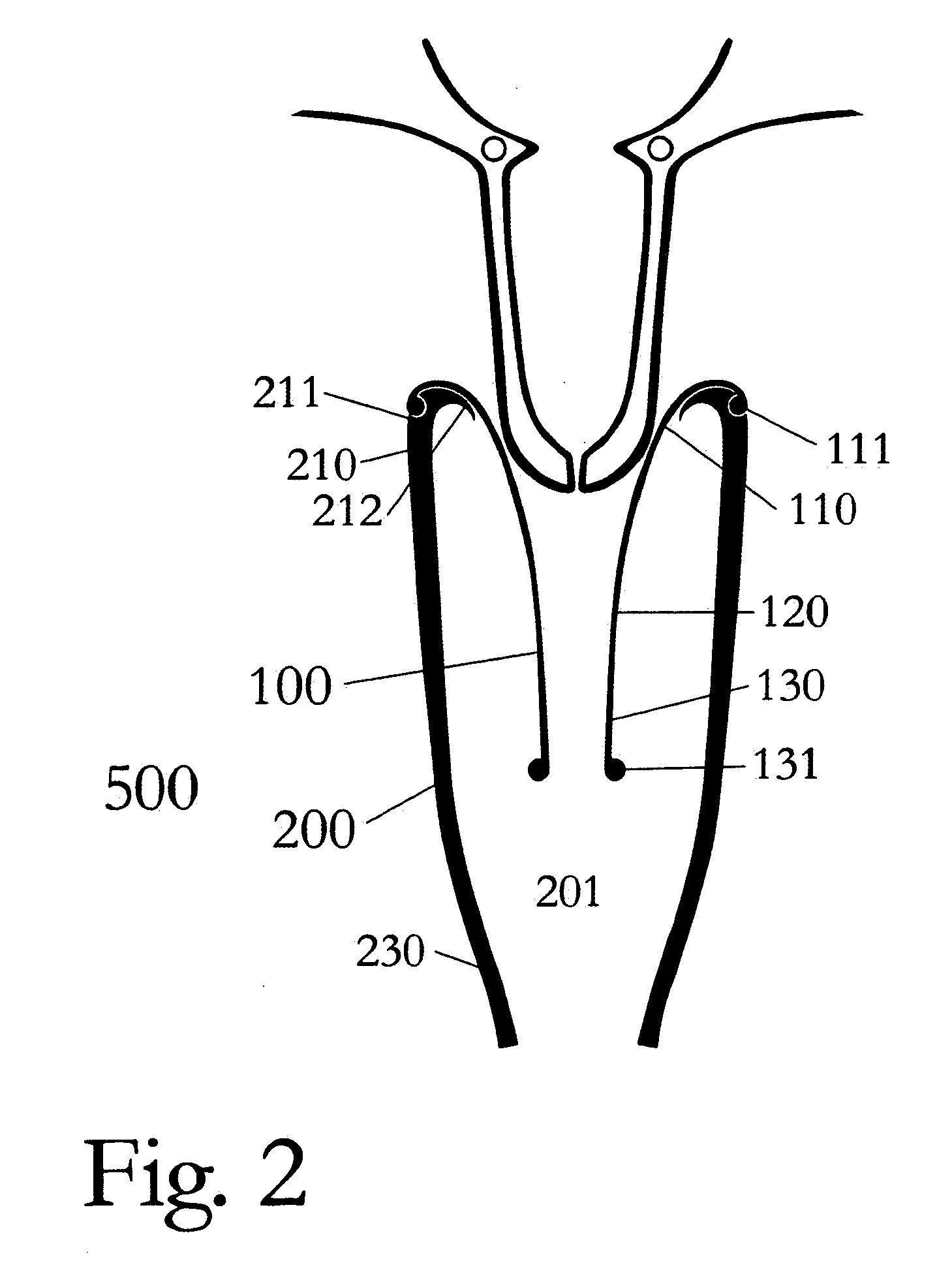Such contact and collapse on the teat by said inventions may traumatize and deform the teat, teat end
sphincter, teat sinus (or teat
cistern in the mammals possessing teat cisterns like most dairy animals), and may result in facilitating
mastitis infections, teat sinus stripping, and the further damage of the animal's health.
Liner collapsing under such application of vacuum and pulsation may expand, extend, damage and compress the teat sinus and teat-end
sphincter mainly in an oval or triangular shape, and may bring the
milking cup to
creep up on the exposed teat, or may cause stripping or overmilking.
Another
adverse effect of exercising high vacuum on the teat, is that vacuum causes blood to concentrate on the
highly sensitive area of the teat, damaging the animal in several ways or making it more prone to damage or harm.
If the vacuum in the teat
cistern is higher than beneath the teat end for short periods of time, the RPG across the teat canal may give rise to bacterial invasion of the teat
cistern.
Overall risks include empty teats (Rasmussen et al., 1994) and overmilking will therefore increase the possibility of
bacteria entering the teat.
This exposes the
mammary gland to the risk of infections from environmental
bacteria (environmental mastitis).
Control of these infections is problematic because the cow's teat sphincter remains open after mechanical milking (McDonald, 1975a).
Most prior art inventions, draw milk in pulses (alternating between pressure and vacuum), considerably encumbering the speed of milk extraction, thus increasing milk-out time and agitating the flow of milk, which might promote
lipolysis which reduces milk quality, and causes the depositing of fat on the walls and tubes of the systems.
These deposits may especially decrease the service life of
elastomer and plastic components of the systems, and encumber
sanitation.
The process currently used for the
sanitation of the apparatuses, may promote but cannot guarantee the
sterility of the items that come in contact with the teat, and after the
sanitation process, they may be the carriers of contaminants.
In sub-clinical mastitis cases for example (which provide the animal handler with few indications), contaminated liners can potentially contaminate the next teats that are milked with it and finally the extracted milk, a case further facilitated if the teat is already irritated or even slightly damaged.
Especially in automated, robotic milking systems, the use of reusable items may cause the uncontrolled deterioration of the structural or
functional integrity and stability, especially of the
elastomer components, which can cause damage to the teat, to milk quality and equipment.
These conditions may encumber the productive process, against milk
hygiene and quality.
Milk quality also affects the price of milk, and may hinder producers from achieving premium prices for their milk, which in turn encumbers efficiency.
Additionally, the use of reusable apparatuses that come in contact with the teat and
udder demand further man-hours for the process of sanitation, a burden on the environment from the waste-products of sanitation, and additional space and expenditures for the supply of sanitation methods and their application.
Breastpumps with high suction pressure and
cycling rate often cause discomfort and pain, while others with low ones are ineffective and incapable at extracting milk.
Prolonged suction can irritate the nipples and cause breast damage.
The cycles in low
cycling pumps tend to be longer and can cause pain since the breast and nipple tissue is suctioned and pulled for too long.
Subject to the size and shape of a nipple, what seems to fit to one
breastfeeding woman may be completely uncomfortable for another.
A small or tightly fitted
breast shield can cause friction against the sides of the tunnel with each vacuum movement of the pump and such friction causes pain, leading to a tender or sore nipple.
It can also affect breast emptying and lead to problems with
milk supply, because the small
breast shield squeezes the small ducts inside the nipple that carry the milk out of the breast.
This results in an incomplete milk removal and can lead to plugged ducts, mastitis, and problems with low milk volume and breast engorgement.
Breast engorgement makes the breast become full, hard, swollen and having difficulty expressing milk or
nursing the infant.
A large or loose
breast shield, through the suction applied, causes the nipple to be further sucked, elongated and expanded into the tunnel of the breast shield, resulting in a swallowed and injured nipple and more pain for the
breastfeeding woman.
Getting used to a breastpump takes too much time and practice for
breastfeeding women.
The pain caused by removing / expressing milk from a sore or otherwise damaged nipple, deters breastfeeding women to remove milk from that breast repetitively and worse said condition and
nursing an infant from an injured nipple becomes too painful.
The use of a nipple shield may be associated with decreased milk transfer, reduced
milk supply, increased nipple pain and / or damage, interference with proper latch on, preference by infant to taste or
sensation of shield, and problems to wean the infant from the shield.
The normal process of extracting milk from human breasts, especially before and after the infant's teeth begin to appear, may be hazardous for the condition of the nipple, as the infant rubs its irritated gums, or newly formed teeth, on the nipple,
biting on it or creating lesions and other irritations.
 Login to View More
Login to View More  Login to View More
Login to View More 


